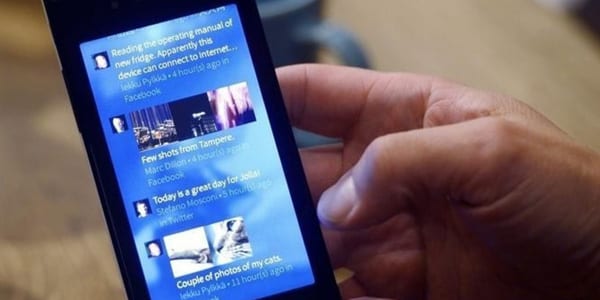 Versions of this article appeared on CNBC.com and the World Economic Forum Blog: Agenda
Versions of this article appeared on CNBC.com and the World Economic Forum Blog: Agenda
The remote control revolutionized how we watched TV—turning some of us into couch potatoes. We no longer had to manually get up to pick one of a few channels. The entry of the remote control in 1955 made channel surfing possible, allowed us to avoid commercials and forced brands to work harder for our attention.
Today’s remote control is far smarter and more interactive: the smartphone. No longer is the remote control used only to make life easier in the armchair, but it is used on-the-go to run your life. Are you reading this on your smartphone right now?
The proliferation of smartphone apps, and our willingness to use them to chat, bank, order dinner and even maintain a healthy lifestyle is not simply evolutionary, it’s revolutionary, particularly in the way we engage with business. We decide which apps to use, how we want to be communicated to, and when we want to order what.
As consumers, we now have the power to decide how pervasive smartphone technology is in our everyday lives. Our habits are changing and our devices and high-speed connectivity are the enablers.
The advent of the smartphone as remote control for our lives has resulted in behaviour changes for consumers, and necessitates behaviour changes for brands.
Internet of Everything (IoE) < Internet of Everyone (IoE)
In this age of highly personalized and customized connectivity, consumers truly control their online destinies. Groceries can be ordered online and delivered by the local market, a regional grocery delivery service like Peapod, or a global player like AmazonFresh; and recipes and fresh, premeasured ingredients to prepare meals from HelloFresh (a Ketchum client) and others. Consumers decide delivery times, how they’d like to be notified when an order is on its way, and whether to repurchase or alter their next order.
Smartphones also play an important role in safety and security. ADT, for example, empowers customers to set home alarms even when we’re away from the house, as well as turn on and off lights that are tied to the system. Nest enables consumers to adjust the temperature in their homes with a few taps from the smartphone app.
Smartphones, wearables and apps on all platforms have an equally critical role in managing our personal health—from tracking our number of steps taken, to calories eaten, ordering prescriptions refills, or even seeing a doctor virtually through your smartphone with apps from companies like Doctor on Demand. In addition, consumers are spending more time researching medical symptoms and investigating diagnoses. In fact, according to Google, 5% of Google search traffic is tied to health related queries, and 50% of all smartphone users have looked up health info online, on the go.
Personally, my shopping habits have evolved as a result of smartphone technology in countless ways. For example, when renovating my home recently, I never even considered ordering all of my items from one retailer. I used multiple sources from all over the world. I skimmed through thousands of photos of light fixtures, compared retailer prices and went to Etsy for one-of-a-kind offers. Seven companies got lighting business from me, with only two fixtures ordered in-store. And I did almost all of it from my mobile device.
The number of ways we can remote-control our lives is growing exponentially. How much more will we as consumers adapt?
An attention deficit, deficit
A recent Microsoft study found that our attention span is shrinking, down to eight seconds in 2015 from 12 seconds in 2000 as we engage more often with our devices. Yes, the attention span of humans is now one second shorter than that of your average goldfish. There is an attention deficit underfoot, and brands have to work harder to counter that.
So, in this new remote controlled world, how do brands succeed in capturing our attention and influencing our decisions in those eight seconds?
Here are six tips for brands to get smarter about smartphones:
1. Be visually engaging—a photo can grab consumer attention and get them to click forward often faster than you can read a description.
2. Write for Google search—the words you choose to describe your products should be the words consumers choose to search for them. The greater the correlation the easier your products will be to find. This puts even greater emphasis on the need for a strong SEO (search engine optimization) strategy.
3. Humanize your brand voice—If consumers are going to engage with you they want you to be responsive, have empathy when things go wrong and feel you are meeting their personal needs. The computer-generated answer is old school.
4. Influencers rule in the trust equation—Today, third-party validation by earned media and influencers are more important than ever to purchasing decisions. According to the Nielsen Global Trust in Advertising Report, 83% of global respondents trust recommendations from people they know, 66% trust consumer opinions posted online, and 66% trust earned editorial content such as newspaper articles. Paid advertising is trusted by only 58-63% of respondents, depending on the media.
5. Don’t put all your eggs in the electronic basket—The new interaction is online and offline. Brand voice is a big part of winning consumers’ trust but it must be consistent with your experience. The brands that get the “say do” gap right are the ones that have carved out an online identity that carries through all of your brand interactions—be it that the item arrived on time, as described and with no complications.
6. Relationships allow for apologies—In today’s fast paced world many brands face reputation challenges. The quicker a company is to personally apologize for a small inconvenience, or have executives address a larger reputation issue, the greater chance they have of keeping your trust.
It is fascinating to see how far technology has come in such a short period of time, and how our consumer behavior has changed as a result. Smartphones have placed immense power into the hands of the consumer—to shop, eat, track our health, manage our entertainment and make us feel safer—all with a click. Are brands putting enough emphasis on the ubiquity of technology as a do-or-die element of their marketing strategies? Will those that don’t dedicate the necessary resources not make it out the other end of the digital revolution? Time will tell.
And yes, you can also change the channel with your smart phone.



